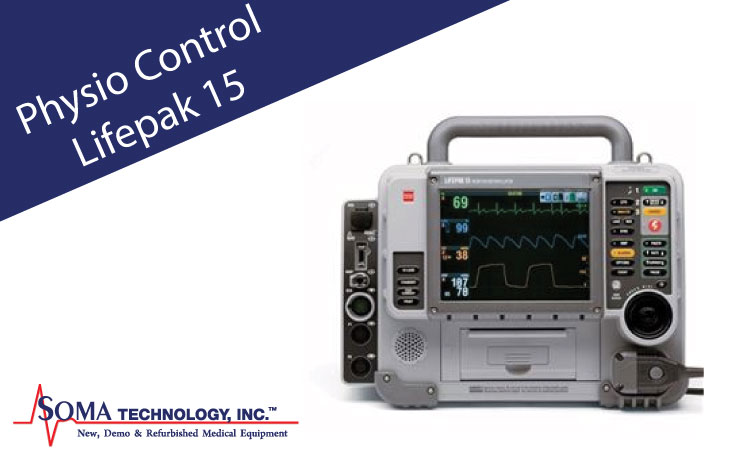Physio-Control Lifepak 15 Defibrillator
January 31, 2019
Physio-Control Lifepak 15
Defibrillator/Monitor
The Physio Control Lifepak 15 is a complete monitor and defibrillator for acute cardiac care response teams. This system was designed for basic life support (BLS) and advanced life support (ALS). The Stryker Lifepak 15 defibrillator is intended for use by trained medical personnel in and out of doors and within indoor emergency care settings. Manual mode monitoring and therapy functions are intended for use on adult and pediatric patients, and Automated external defibrillation mode is intended for use on patients eight years of age and older.
Physio-Control Lifepak 15 Batteries
The Physio-Control Lifepak 15 operates only on battery power using two lithium-ion batteries, which must be removed from the device and charged in the Station or Mobile Li-ion Battery Charger. The batteries for the Lifepak 15 are not interchangeable with batteries that are used in other Lifepak defibrillators. Each battery has a fuel gauge that indicates the approximate charge level in the battery. If the battery only shows two or fewer LEDs immediately after completing a charge cycle, the battery should be replaced.
Monitoring the ECG
The electrocardiogram (ECG) is a recording of the electrical activity of the heart. ECG monitoring allows for the identification and interpretation of cardiac rhythms or dysrhythmias and the calculation of heart rate. The ECG is obtained by placing either electrodes or paddles on the patient and allows the heart’s electrical activity to be monitored and recorded. ECG Monitoring is a tool used in addition to patient assessment. Care should be taken to assess the patient at all times; do not rely solely on the ECG monitor.
Acquiring a 12-lead ECG
The 12-lead ECG offers paramedics and emergency physicians significant advantages over the single-lead ECG trace typically available in EMS. The 12-lead ECG not only provides a diagnostic quality ECG for use in the detection of ST-elevation myocardial injury, but anticipates associated potential complications, and implements treatment strategies accordingly. In addition, the 12-lead ECG provides a baseline for serial ECG evaluations. The 12-lead ECG transmission to the emergency department is recommended by the AHA and ERC for patients with Acute Coronary Syndrome. When transmitted from the field, 12-lead ECG has been shown to shorten the time from in-hospital treatment by an estimated 10 to 60 minutes. Documentation of transient or intermittent arrhythmias and other electrophysiologic events that are offered in the prehospital setting can assist in diagnosis and treatment decisions in the ED.
Computerized ECG analysis statements are automatically printed on 12-lead ECG reports. Printing of the interpretive statements is a setup option and may be turned off in Setup mode. These statements about myocardial injury, infarct, and ischemia are derived from measurements made on a signal-average beat (median beat) formed for each of the 12 leads. The analysis program is adjusted for patient age and sex. The University of Glasgow 12-Lead ECG analysis Program is used on the Lifepak 15.
SpO2, SpCO, and SpMet Monitoring
SpO2, SpCO, and SpMet are optional features for the Lifepak 15 monitor/ defibrillator. When all three options are installed, the pulse oximeter measures functional oxygen saturation, carboxyhemoglobin concentration, and methemoglobin concentration in the blood. SpO2-only sensors and a combination of SpO2, SpCO, and SpMet sensors are available for this unit.
The pulse oximeter is a noninvasive device that continuously measures functional oxygen saturation (SpO2), carboxyhemoglobin concentration (SpCO, and methemoglobin concentration (SpMet) in the blood. Continuously monitoring SpO2 can provide an early warning when oxygen saturation is decreasing and can help the clinician act rapidly before the patient develops the later signs of hypoxemia. Previously, the blood parameters SpCO and SpMet could only be obtained from invasive blood gas samples. This new technology assists in identifying the often hidden conditions of carboxyhemoglobinemia (carbon monoxide poisoning) and methemoglobinemia (a condition that impedes the delivery of oxygen to the tissues). Low levels of both SpCO and SpMet are normally found in the blood; however, early detection of significantly high levels can lead to proper diagnosis. Treatment can help improve patient outcomes.
Final Thoughts
Have you ever used the Lifepak 15 before? Have you ever used a defibrillator? Do you trust the technology from Physio-Control? Are the features that you enjoy using, or some that you would change? Comment below!
Explore Other Blog Items By Category
Recent Posts


Surgical Microscope Rentals

